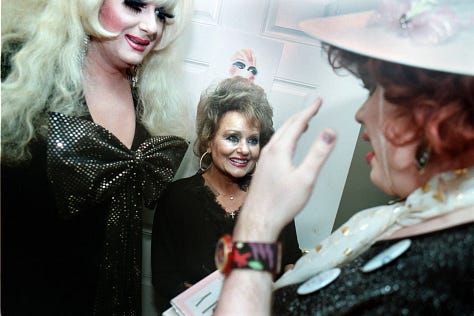Jesus Camp; Tammy Faye, Televangelism, and Cringy Christian Influencers
Jesus (and America) is watching.
As someone Jewish, I find myself thinking about Evangelical Christians a lot. More than most people, I think. They may be on all of our minds since they have made themselves hard to miss in recent history. The continuous rise of Christian Nationalism in America, the re-election of Donald Trump, the countless TLC specials about the Duggar Family, and the new age of cringy Christian influencers on social media have kept the Evangelical movement in the news and often at the forefront of my mind.
Sometimes (a lot of the time, if I’m being honest), I find myself laughing in horror at these people, or maybe more accurately, the content they create in hopes of evangelizing. “These people”, feels horrible to write, but honestly, I don’t know what else to call them. On one hand, I do not want my writing about them to come off as dismissive or as mocking. And yet on the other, I can’t just sit here and not chuckle at a Christian ASMR YouTube channel titled “Christian ASMR; Doing Your Makeup For a Date (Biblical Dating Advice + Layered Sounds)”. Despite the absurdity of this kind of content, I cannot act as though this type of media and the people who make it are silly or harmless. The truth is, I take them very seriously. I find the growing popularity of their rhetoric, their online presence, and their impact on the American government fucking terrifying.
While the internet has lent itself to a new type of Christian Influencer, the idea — and a whole separate world of Christian Media in general — is not new at all, neither is their impact on American politics. Pastors have been using various forms of media to spread the word of God since the 1920s, first using radio and eventually television. The shift to a visual medium allowed televangelists new access to the public -- directly through their television screens. This new mode of preaching allowed for something radio could not, visual images. This allowed viewers to connect directly with whatever spiritual leader was on their screen. In turn, televangelists used methods we see throughout other forms of film entertainment, a reliance on expression, drama, emotion, and most notably, a cult of personality. Quintin J. Schultze describes this phenomenon in his book Televangelism and American Culture: The Business of Popular Religion:
Along with the laughing looks of comedy stars, the tragic expression of soap opera characters, the authoritative stares of newscasters, and the sensuous glances of commercial models are the expressive faces of televangelists. Day in and day out––on cable, over the air, and through satellites––the facial images of televangelists are delivered electronically to viewers. In the privacy of the viewers' homes, television recreates those images on picture tubes… Television inherently creates the illusory sense that preacher and viewer are communicating personally.1
One of the clearest manifestations of this was the PTL (short for Praise The Lord) Network, founded by Jim Bakker and his then-wife Tammy Faye in 1974. Their show, The PTL Club, followed a format similar to the Tonight Show, with Jim often preaching, interviews (including one with Colonel Sanders of KFC), and Tammy singing ballads in front of a live audience. Watching clips of the program, it’s hard to miss the kitsch and camp of it all. Tammy Faye, with big blonde hair, bright blue eyeshadow, loads of black mascara, and giant gold earrings talking passionately about the freedom of Christ, often sounding as if on the verge of tears. As she speaks she gestures with her hands accented by long, perfect cherry red acrylic nails. It’s easy to understand when you watch her how someone at home would be enthralled by her. Her energy is high, her emotions on display, and she is unapologetically herself.
Sure, their show was about Jesus, but the reason it was so successful was because the Bakkers knew how to get their audience invested, and how to build a parasocial relationship with their viewers and gain loyal support. Even after Jim was sentenced to 45 years in prison for fraud and conspiracy, even after he was accused of sexual misconduct and resigned, many of his supporters still stood by him.
The truth was that the Bakkers were enormously gifted television performers who turned the program into a real-life soap opera about their own lives and the success of the ministry itself. Just as some other televangelists successfully created appealing stories about their ministries, with viewers and contributors playing key roles, the Bakkers almost inadvertently learned over the years how to engage supporters in a spiritual battle against evil forces supposedly conspiring to destroy PTL.2
These TV shows were not dull, formulaic pulpit lectures on Christianity. As Schultze writes, “Televangelism reflects the American preoccupation with stardom and celebrity status. Americans are not as interested in ideas and perspectives, debates and dialogues, as they are in people and personality”.3 A dry lecture on the bible would never keep the attention of the American public, while Televangelism mesmerized audiences… It exists truly as an American and capitalistic art form. While in the past, dedicated and saintly Christians would prove themselves through pain and suffering, modern-day televangelists proved their legitimacy through material wealth. If they weren’t one of God’s chosen subjects, would they have a private jet? These ideas fall under the category of the “prosperity gospel”, popular among charismatic preachers and televangelists. Jim Bakker himself wrote in his 1980 book The Eight Keys to Success, “God wants you to be happy, God wants you to be rich, God wants you to prosper.” Therefore, if you are truly a follower of Jesus, if you really are a good Christian, you will be able to buy an air-conditioned doghouse (yes the Bakker’s did spend money they embezzled for this), that is God’s design, after all.
The fall of the Bakker’s televangelist empire is straight out of a daytime soap opera, but ultimately, Jim Bakker’s pursuit of wealth landed him a prison sentence. However, the part I want to hone in on is where it led his ex-wife, Tammy Faye. After being released from prison, Jim continues to be a horrible person (blaming Obama for Hurricane Harvey in 2016 while continuing to shill his buckets of end-time food to his viewers, falsely saying a supplement he sold cures Covid), but Tammy went down a different and much more surprising path. She became a campy, gay, icon.



It was a redemption not by Christ but by camp: Tammy Faye with her waterworks-tears, Betty Boop voice, acrylic nails, and self-deprecating humor seemed just too delicious to be all bad.4
Tammy had always been campy, even during her time on PTL. She had also always been relatively groundbreaking. On November 15th, 1985, Tammy Faye interviewed Steve Pieters, a reverend and openly gay man living with HIV, on live television. She treated him with compassion, respect, and clear empathy. This was only a couple of months after Reagan finally bothered to acknowledge the reality of AIDS publicly, and the topic was unsurprisingly taboo and loaded in Christian circles. Having someone so notable in the Christian media having a genuine conversation with a member of the LGBTQIA+ community living with HIV was incredibly moving, but more importantly, impactful. At its height, the PTL Network, where Tammy’s show “Tammy’s House Party” was broadcast, reached 20 million viewers around the world. In a 2021 interview, Pieters said of the segment, “I have been amazed at how those 25 minutes I spent with Tammy Faye have reverberated through my life, more than almost anything else I've done. So many people have said my interview with her helped them come out or even saved them from suicide, by helping them realize they could be gay and Christian, or that God was not punishing them with AIDS for being gay.”
Tammy Faye’s acceptance and embracing of the queer community without a doubt elevated her to become the camp icon she is today. After Jim was sent to prison, Tammy became a much more vocal supporter of the community, even attending Washington’s Capital Pride Festival and judging drag competitions for her look-a-likes. She worked with gay advocacy groups, befriended Lady Bunny, RuPaul, and the founders of World of Wonder (yes, the very same that produces the Drag Race franchise), Fenton Bailey and Randy Barbato. These connections led to the 2000 documentary, The Eyes of Tammy Faye, directed by Baily and Barbato, that followed Tammy Faye and depicted her with sympathy, a woman that had the Christian community turn against her after losing an empire, reshaping the public image of her. Tammy was no longer just Jim Bakker’s ex-wife, no longer a disgraced televangelist. No, Tammy Faye was a camp icon, an honorary drag queen, and a Christian who accepted the gay community with open arms. In an interview with Larry King, Tammy explained, "When I went – when we lost everything, it was the gay people that came to my rescue, and I will always love them for that."
Yes, Tammy Faye is a gay icon, she is camp, without a doubt. But even before she was reinvented as such, the PTL and many aspects of the televangelist world felt campy, albeit unintentionally (what Sontag refers to as “pure camp”). There is something about the contrast in the intersection of Christian beliefs and popular culture that feels ripe for camp. Think of Christian metal bands, Tiktok preachers and faith healers begging for likes, the Jonas Brothers, and Disney Channel stars publicly wearing Purity Rings and vowing to wait until marriage while accepting a Teen Choice Award.These examples of popular culture intertwining with evangelizing feel campy to me. In the essay, “Faith in Technology: Televangelism and the Mediation of Immediate Experience,” Shane Denson discusses how televangelism and Evangelicals have found ways to use technology and popular culture to both participate, establish principles, and still distance themselves from secular society.
The separation of form and content is not merely an academic invention; more fundamentally, it is a strategy by which practitioners of conservative religion can participate and simultaneously distance themselves from the modern world…They are forms of modernity, but forms that allow their practitioners (whether producers or consumers) to “stay tuned” to this-worldly contexts while instilling a self-conscious perception of difference, a dissonance with mainstream society owing to an other-worldly instance.5
The difference, the dissonance, is what breeds campiness. And it is not innocuous. On his new show, Jim Bakker hocks doomsday food buckets to his audience, like QVC for Christian doomsday preppers. In one episode, Laurie Bakker, Jim’s second wife and co-host, encourages the audience to stand up and dance. A large man appears on stage, wearing a brightly colored Hawaiian shirt with a microphone, and gives a soft laugh saying he loves the summertime. He then begins singing a rendition of “My Girl” by the Temptations, only his is rewritten to be about the Rapture. He strolls across the stage, singing about bulk bean burgers and chips the audience can buy. He gives a small entertained chuckle before singing, “I guess, you’d say, Jim and Laurie help me be prepared today for End Times… I’m talkin’ bout End Times…” as he looks directly into the camera and smiles at the viewer.6 I laugh because it’s funny to see someone so joyfully singing about the rapture to the tune of an R&B classic, to see this man so cheerily advertising bulk food for the end of the world. I laugh because it is funny, it is campy, it is surreal. I laugh and then I remember that it is genuine, and even then I still have to laugh because what else is there to do when you see something like this?
Schultze, Quentin. Televangelism and American Culture: The Business of Popular Religion. Wipf and Stock, 1991. https://archive.org/details/televangelismame0000schu/mode/1up.
(Schultze, 1991)
(Schultze, 1991)
Giese, Rachel. “Was Tammy Faye Bakker Too Deliciously Camp to Be Bad?” Xtra Magazine, September 17, 2021. https://xtramagazine.com/culture/tv-film/eyes-tammy-faye-review-208844.
Denson, Shane. “Faith in Technology: Televangelism and the Mediation of Immediate Experience.” Phenomenology & Practice 5, no. 2 (December 17, 2011): 93–119. https://doi.org/10.29173/pandpr19847.
Compilation of Jim Bakker’s Doomsday Food Buckets, 2022. Clip at 2:59




